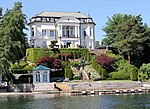The Oslo Tunnel (Norwegian: Oslotunnelen) is a 3,632-metre (2.257 mi), double-track, railway tunnel which runs between Olav Kyrres plass and Oslo Central Station (Oslo S) in Oslo, Norway. The tunnel constitutes the easternmost section of the Drammen Line and runs below the central business district of Oslo. It features the four-track Nationaltheatret Station, Norway's second-busiest railway station, where the Oslo Tunnels lies directly beneath the Common Tunnel of the Oslo Metro. At Frogner, the Elisenberg Station was built, but has never been used. The tunnel is the busiest section of railway line in Norway and serves all west-bound trains from Oslo, including many services of the Oslo Commuter Rail and the Airport Express Train.
Traditionally, Oslo had two stations, the larger Oslo East Station (or Oslo Ø, located at the spot of the current Oslo S) and Oslo West Station (Oslo V), which served the Drammen Line. This caused a physical barrier between the two parts of the railway network, only connected by the Oslo Port Line which ran partly in city streets. Formal planning of a central station and a tunnel connecting the Drammen Line to Oslo Ø started in 1938, and the final plans were approved in 1968. The Oslo Tunnel opened on 1 June 1980, and made it possible to close Oslo V in 1989. Nationaltheatret saw a major upgrade in 1999, when it was expanded to four tracks, and from 2008 to 2010, the tunnel saw a major technical upgrade. There are plans to build a second tunnel to increase train capacity west of Oslo.











